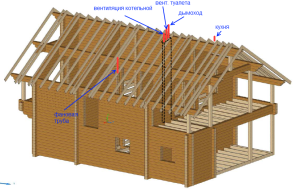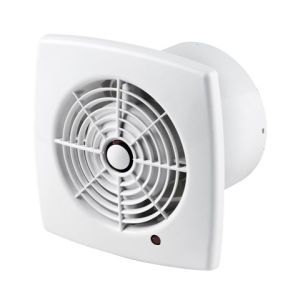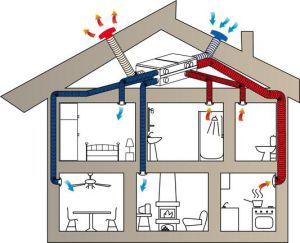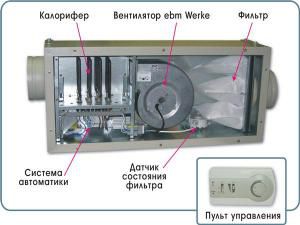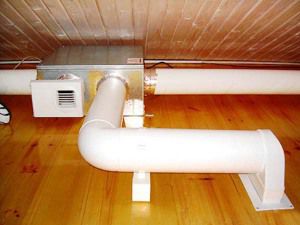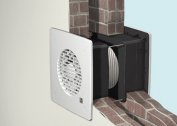To live in a house built of wood means to enjoy comfort and peace. Such a house stores the smells of the forest, it saturates you with the positive energy of nature. But to breathe in it even easier, arrange effective ventilation in a wooden house with your own hands. Then your home will become truly comfortable. Understanding how to make ventilation in a wooden house will give you the determination to get down to business as soon as possible.
Do you really need ventilation in a wooden house?
Many times we have heard the statement that the tree “breathes”. We repeatedly remembered the Russian stove with a kind word, which supposedly served as natural ventilation in the hut. All this is true, but applies only to old peasant huts. There really was no need for any kind of ventilation in the wooden house, because without that it could be seen from all the cracks.
A completely different thing is a modern wooden house. What a “breath” of a tree, when the walls are made of glued timber! For builders, the main task is to keep heat and prevent drafts, so the house becomes like a tightly closed wooden chest. But the lack of air flow leads to the fact that natural ventilation in a wooden house does not work and the air stagnates.
That is why the question of whether ventilation is needed in a wooden house can be considered incorrect.
Of course, in a wooden house, as in any other, it is necessary to equip a ventilation system. What type of system you choose - natural or forced - you decide, based on the specific conditions of your home.
Getting to the ventilation device in a wooden house with your own hands
Suppose that you yourself were engaged in the construction of your cottage, or at least participated. Therefore, you have gained experience in carrying out construction and installation works, and ventilation in a wooden house with your own hands will not seem to you too difficult a technological task. Suppose also that you have some locksmith and carpentry tools in your closet. Therefore, we will not begin to teach you how to hold them in your hands, but right away we get to the point and consider the main points of the ventilation device in a wooden house.
The whole range of activities needs to be divided into several stages.
First, you need to design the ventilation system in your wooden house in such a way that its performance complies with the approved standards.
Norms of air exchange in various purpose-purpose home premises:
| Kitchen with gas stove | 70 m³ / hour |
| Kitchen with electric stove | 50 m³ / hour |
| A bathroom | 30 m³ / hour |
| Bathroom | 50 m³ / hour |
| Living room | 30 m³ / hour |
| Utility room | 15 m³ / hour |
Only based on the results of sound design, you can accurately determine the necessary parameters of the ventilation system, taking into account the layout of your home.
Secondly, equip the ventilation ducts and mount the air ducts in accordance with the scheme drawn up by you. By the way, the most correct plan and outline the ventilation scheme in your wooden house will help a professional designer, if you consider it necessary to contact him.
Thirdly, to check the operability of individual elements and the entire ventilation system as a whole, and if deficiencies are found, try to correct them.
Natural ventilation of a wooden house
The natural ventilation system in a wooden house is attractive for its comparative low cost, as well as the simplicity of the device. The movement of air is due to the desire of the warm air mass to rise upward through vertical channels, specially built for this. Therefore, for you, natural ventilation in a wooden house with your own hands may be the most simply feasible, and at the same time quite effective.
Arrange ventilation in a wooden house from the basement, since it is here that air from the outside must first enter. Under normal conditions, the ventilation of the foundation of a wooden house occurs through the so-called vents. These small ventilation openings should be laid under each wall of the house during construction.
The air supply through the supply duct must be arranged at the basement level. It’s best on the north side of the house, where the air is the coolest, and this is useful for enhancing traction. It is not necessary to equip each home premises with a separate supply duct. It will be enough to leave gaps of one and a half to two centimeters under all internal doors, and through them fresh air will spread everywhere. The exhaust air will naturally be displaced through the exhaust ducts, the entrances to which must be arranged under the ceiling of each room and covered with decorative grilles. The output of each of the ventilation ducts needs to be raised as high as possible above the roof level.
Equip the air ducts with valves or plugs, covering which you can adjust the air exchange rate.
When you arrange natural ventilation in a wooden house with your own hands, make separate ventilation ducts for each type of room. That is, one channel for extracting from the kitchen, another for the bathroom, a third for the bedroom, etc. Of course, it is tempting to make one single pass through the roof instead of four. It will seem to you that this will save money and effort when installing ventilation in a wooden house, but it is unlikely to be useful. After all, in strong winds, back draft can occur in the exhaust duct, and then, for example, odors from the sewer will penetrate into the rooms.
In addition to atmospheric phenomena, other factors also influence the traction force in the ventilation duct:
- vent pipe height;
- the size of the inner hole of the channel;
- number and configuration of turns
- the presence of insulation hoods.
Consider these points when you will install ventilation in a wooden house.
In addition, in summer there is a minimal temperature difference at the lower and upper points of the ventilation duct, so the draft is almost absent. Under these conditions, it will be necessary to arrange ventilation through open windows more often.
So that the air flow does not meet obstacles when passing through the ventilation duct, its inner surface should be smooth and not have narrowing at the joints.
In a small wooden house, it is not necessary to build brick ventilation shafts. This work is laborious, and in addition, dust will accumulate on the rough surface of the channel. When you decide how best to make ventilation in your wooden house, opt for smoother metal or plastic duct blocks.
When you do the ventilation device in a wooden house with your own hands, do not forget that the space under the roof also needs air circulation. If the topmost room is built as a residential attic, it is necessary to equip the same ventilation as in other rooms.And if the attic is non-residential, then it should be aired through special equipped holes in the roof.
Forced exhaust ventilation in a wooden house
It often happens that the natural flow of air does not have time to refresh the atmosphere in the home. Then the owner wonders if reinforced ventilation is needed in a wooden house. You can complement the system by installing an electric fan, which will increase the exhaust power. Install it at the mouth of the exhaust duct in the same room where, according to the ventilation scheme in a wooden house, increased air exchange is required. For example, in the kitchen or in the bathroom.
Choose a fan in accordance with the diameter of the ventilation duct into which it is to be mounted. Keep in mind that the fan power must be sufficient so that the ventilation system in the wooden house provides an efficient exhaust hood in each particular room. If it turns out that the fan is weak and can not cope, you can also install a fan to help it to pump external air.
When installing the fan, connect it to the light switch in the bathroom, then it will stop simultaneously with the off light.
In the case of forced draft, as with natural ventilation, it is not recommended to combine the hood from different rooms into one ventilation duct.
Supply ventilation of a wooden house
In addition to natural ventilation in a wooden house and the use of an exhaust fan, there is a more effective way of air freshening. Equip your own ventilation system, which is also able to provide enhanced exhaust. Such a device will provide complete air exchange throughout the home, starting with the ventilation of the foundation of your wooden house and ending with the attic.
Supply ventilation solves several practical problems at once:
- fresh air outside;
- filtering the supplied air and cleaning it from dust;
- heating the air flow passing through the channel;
- removal of polluted air outside the premises.
Many varieties of equipment for ventilation systems in a wooden house from various manufacturers are produced. To find out which one will be most useful to you, ask for advice on the purchase.
You can purchase the entire kit disassembled and do the ventilation device in a wooden house with your own hands. But if you order individual elements of the system already assembled, this will facilitate your work.
The set of equipment for fresh air ventilation may include:
- duct fan, providing air flow from the outside;
- electric heater for heating air in the winter;
- humidifier too dry summer air;
- silencer to suppress vibration from a working fan;
- filters that prevent dust from entering the system.
In addition, the system can be equipped with automatic control and management.
In order to protect the floors from vibration and from the danger of fire, you need to install the units on a low podium. During the installation of ventilation in a wooden house, make the air supply and exhaust routes hidden in the ceilings and under the ceiling.
When mounting system elements, do not forget to consult the instructions attached to them.
You will need to make the wiring of the air ducts in accordance with a previously drawn diagram. The main importance of the design is that the distance from the air exhaust points under the ceiling of each room to the ventilation unit in the attic should be as small as possible.The ducts themselves can be metal or plastic, their connections are conveniently made from flexible corrugated pipes.
Do-it-yourself ventilation in a wooden house will be effective if you make a fresh air intake channel in the pediment of the house, and remove the outlet through the roof. Although it is desirable for natural ventilation that the supply pipe be located as low as possible, this is not critical for a forced system. On the contrary - the higher the air inlet is from the ground, the less dust will enter it.
The diameter of all ducts must be the same in order to prevent inhibition of the air flow at the joints.
Supply ventilation with recovery
This system is a type of conventional forced ventilation. Do you need such ventilation in a wooden house, in which the frosty winter air will be heated, but the energy consumption for heating will be minimal? Probably needed. Then the recuperator will help to fulfill your wishes. This unit operates on the principle of a heat exchanger, it heats the incoming air due to the heat of the removed air mass. However, both streams do not mix.
In the summer, the recuperator can be paired with an air conditioner and partially cool the air passing through it due to the already cooled room atmosphere.
Checking the ventilation of a wooden house
It doesn’t matter which one — the natural or forced ventilation you installed yourself in the wooden house — it must be effective. To accurately check the operability of the ventilation system, there is an anemometer measuring device. But you can do it with improvised means.
Take a shred of a thin paper towel and bring it to the grate of the exhaust vents under the ceiling. At the same time, the supply channel (or window) must be open. If the hood operates, a piece of cloth will react to the movement of air and will reach the mouth of the ventilation duct. In the same way, the airflow can be determined by the flame of a burning candle.
Do not try to check the old ventilation ducts overgrown with cobwebs and dust with an open flame, in order to avoid fire!
In the future, try to pay attention to whether condensation appears on the windows in cold weather, whether mold is wound up in the corners, or if the walls become damp. These signs will signal you that it is time to do preventative cleaning of the ventilation system.
Finally, we suggest watching a video that helps to understand the importance of ventilation in a wooden house.
We hope that you figured out how to make ventilation in a wooden house, and have already taken steps to translate the theory into reality. Not so complicated as it seems at first. The main thing is to choose the right type of ventilation system and calculate its performance, as well as carefully mount all its structural elements. And as a result, you will find excellent well-being due to the constant freshness of the air in the home microclimate.
